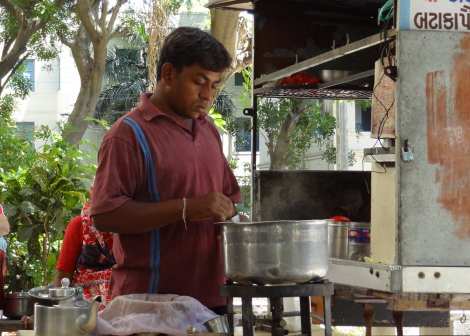MY TRIP TO INDIA
In the Spring of 2013 I spent from April 21 to May 20, in Anand, Gujarat, India. And, as said on an old TV show, “This is my story.” This information was originally written as a travel blog on my FromtheDeskofAnnAdams.com blog which is primarily, but not totally. EFT oriented. There are lots and lots of pictures. People who read the original blogs had nice things to say – so – Enjoy!
The purpose of my trip to India was to visit my niece, Dee, who has worked as an English Language Fellow consulting at a teacher training college in Gujarat for a year and half. She has adapted well. She’s worked hard to make the job of teaching English to children an easier and more effective process. Her books can help children learn English as a second language regardless of their native language. There are indeed many ways to contribute to making this world a better place. Check out her contributions at Studydo (for free downloads of her books) and DBePub.com, her personal web site for consulting with would be Kindle authors.
We traveled together to many of the rural areas in Gujarat. This was a unique trip to areas that generally tourists don’t see – in fact, I saw very few tourists while there and those were from other parts of India or Asia. After arriving in India and traveling to Anand, I saw no Americans or Europeans until the airport for my return to the USA.
I expected the cows walking the streets and the trash everywhere. I didn’t expect the camels pulling long flat carts – I’d never seen a camel outside of movies and was a bit surprised at how truly B-I-G they are. They are used to carry flat carts to deliver larger items in Anand. The camels make their way just fine among the other traffic whether a small dirt road or on the expressway as below.
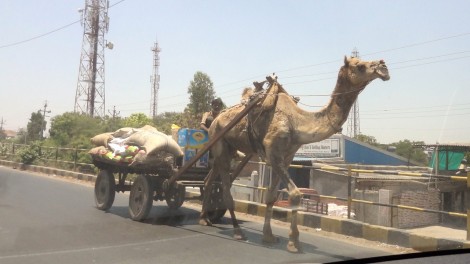
There were certainly a variety of ways to travel. The number of scooters and motorcycles is amazing. They are certainly not as worried about safety; saw 2 helmets the entire month. The scooters/motorcycles are often seen with a entire family aboard – with as many as 5 people on one motorcycle speeding down the road. Even more surprising is that the females often ride side saddle behind the driver – even while holding a baby.
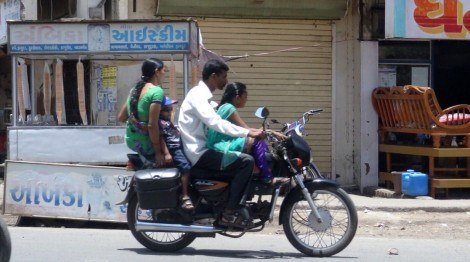
One of my favorite was the little “cars” that operated like taxis. Many of these small open “cars” were loaded with as many as 15 people – I had no idea you could get that many people in a car that size. What was even more interesting is that they would want to get in – and pay for it.
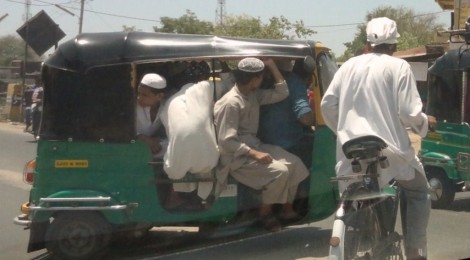
These four boys are on the way to a cricket match. Cricket is as big as football and soccer in other parts of the world.
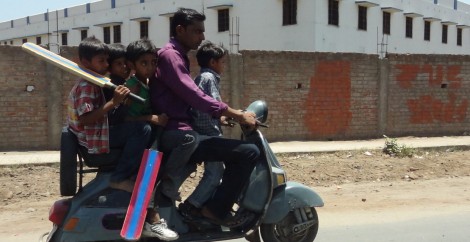
All drivers seem to be in love with their horns too. That, however, is a good thing as they seem to regard traffic lanes as optional. Even on the expressways though the speeds rarely exceeded 50 or 55.
There are a huge number of birds, all kinds of birds, and lots of trees here for them to nest in. They consistently gather right after sunrise and just before sunset. The sound of them is so much a consistent part of this area that you can set your watch by it. One of my niece’s friends told her she would meet us at the park “when the birds come.” So far, the birds have awakened me every morning.
The people are very hospitable. I have been wearing the informal Indian clothes in an attempt to fit in. People stare at me anyway. The women wear their hair long and unless they are very old generally dye their hair. So I suppose I really do look different with short grey hair and lighter skin even if I am dressed like most of the other women.
My niece lives in a second floor flat adjacent to the girl’s dormitory. Large monkey’s often congregate in the trees outside her window. Not sure if she enjoys watching them any more than they seem to enjoy watching her! But watch is all you’d want to do. If you meet a group of monkeys as you walk into town you tend to move to the other side. Not what you’d call friendly creatures. The monkeys are big, about 3 feet tall and tend to walk on two feet and hiss at people – definitely intimidating.
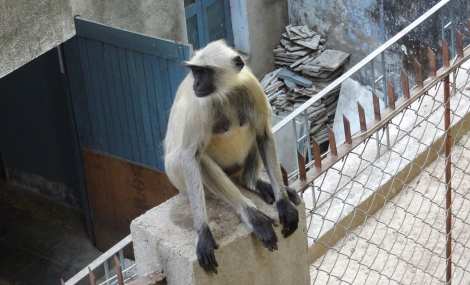
Pets are rare. Wild dogs roam the streets and they all look like this one.
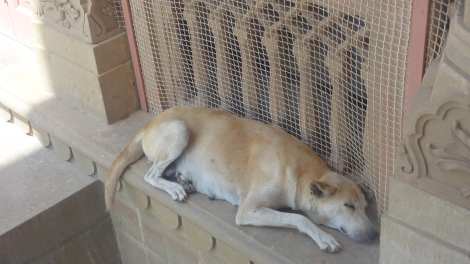
The first floor of her flat contains a social service type program working to educate the local women about health issues. They also reinforce the new government slogan “Save the Girl Child.” This is a large concern as in some areas of India, the ratio of men to women is 10 to 7.
I’d love to be able to talk to the trainers about what they are doing and share EFT, but the trainers and attendees only speak Gujarati.
VILLAGE SCHOOLS IN INDIA
Ekta, school teacher in training, practicing the new materials with the children. Notice the kids at the door. They were not in that class but so interested they just hung out at the door.
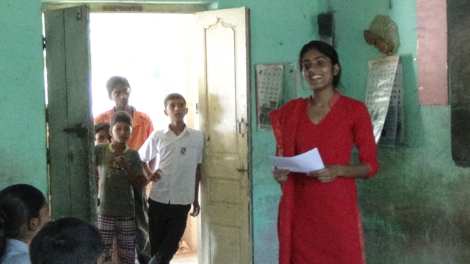
We rode in one of the little open cars, with a lot of other people :-), to a small village school, Tranol, a 45 minute ride. Ekta, an incredible beautiful Indian young woman, came with us. Ekta was a graduate student of my niece who was helping her with a project. In Tranol, in a local village school, I helped my niece video a demonstration, by Ekta, of the new material Dee’s designed to make it easier to teach language to children. Apparently Indian schools tend to focus on teaching English literature but not the spoken English language. With the global economy more businesses in India want employees to be able to speak English well – or as my niece calls it, produce language – not just read it. This push from business is influencing the desire to make changes in the way they teach English. My niece has been asked to help with the changes they are making.
And, not to brag on my niece – well, yes, absolutely to brag on my niece – the material Dee has developed to make it easier and more interesting for children to get better at speaking English is impressive. She’s written a book (now several books) that will be used in Gujarat school system and other states in India are interested. This information, while not for the very beginner, could help make the job easier for any English as Second Language teacher no matter what language the child speaks. She’s putting the last touches on her web site so others can download the info for free; cut and paste: http://studydo.asia/ Dee is passionate about getting this method out to the world and is giving it away to anyone.
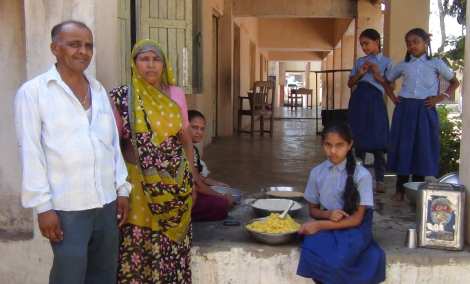
The schools in the village remind me of the elementary school I attended in Doraville, GA in the 50s. No air conditioning. Open windows with no screens. We had wooden plank floors; they had cement. The school lunch ladies prepared our food in a large kitchen with a back door to a large porch where they sat cutting up green beans and such. Our lunches were made from scratch like they did at this village school. Here, though, their kitchen is the big porch where they squat at a portable two burner gas stove.
A couple of the older girls were helping – the girls in their uniforms, the ladies in their Sarees. In my school we were served by our lunch ladies from big pots to our plates. Here the kids, after washing their hands, were served from a big stainless steel bowl onto their small stainless steel plates with sides. And like many of my classmates long ago, for many this was the only meal they had that day.
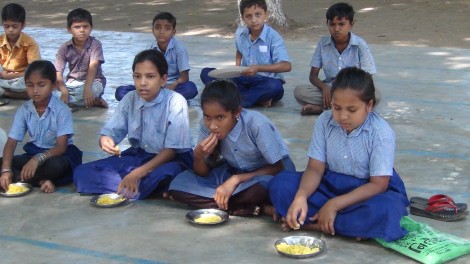
This day the children had a rice dish. Like us, they could go back for seconds. Unlike us, however, they ate their lunch with their hands – which explained the sides on the dish – gotta push that rice against the side to get the last bit. After lunch the kids washed their hands and their dish at a faucet next to the porch; stacked them neatly and handed them back to the “lunch ladies” who then finished up the washing at the faucet.
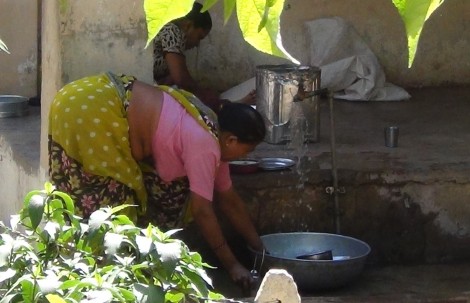
And just as I did as a child, after lunch these children played their version of hop scotch using big circles instead of our “boxes.” The children here are beautiful and amazingly clean in a country where many people live in structures open to the environment and there is more dirt than grass. The kids were very curious about me and my camera and practiced their English asking over and over the names of various objects, “What is this?”
THE WASHER WOMEN IN INDIA
We were invited to tea at a home located across the street from the school. We drank tea sitting on a large flat swing on a porch with deep overhangs and a breezeway. The area was painted bright yellows and pinks. It was cool and pleasant. Through one door way we could see a small “room” that had a ledge at the door of about 8 inches, with low faucets and a drain in the middle – sort of like a large shower. An older woman squatted there hand scrubbing this family’s clothes, rinsing them in a bucket and wringing them out by hand.
This was apparently a common practice as at another home we noticed a washer woman squatting beside a big basin area just outside the back door with the water faucet. She was hired by the family to wash clothes in a large (about 24” in diameter) rounded metal bowl. In India this level of labor is very cheap.
Another day on the way back to Anand we passed a group of women washing clothes on a cement slab with drains and faucets lined up in rows on the cement wall. Obviously set up for the purpose of washing clothes, or children, there were over 20 women beating their clothes with flat sticks or rising and wringing. Ekta told us that often the women had to walk miles carrying the laundry on their heads in large stainless steel bowls to wash their clothes. That had to be even much heavier as they carried their clothes home wet.
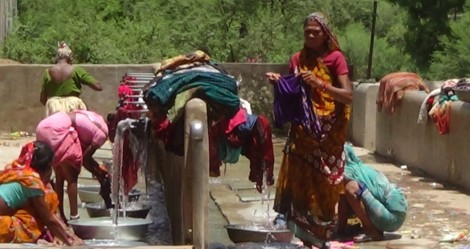
Watching these events brought to mind my 2 years in Turkey when I had two babies in diapers and a husband’s uniforms to clean. We lived off the base. Washing clothes entailed building a fire in the hot water heater at night and, after everyone’s bath, filling the tub with the warm water and soaking the clothes overnight. In the morning my two year old and I got in the tub and stomped around for awhile – she loved it. Then there was the wringing out – by hand – then rinsing and wringing again. Then the 3 flights of stairs to the roof to hang them out – a challenge with a 2 year old and infant. Then back to take them down. Boil the starch. Starch the uniforms, back to the roof. Down again, sprinkle, let rest in refrigerator. Iron. Overall a two hour task per uniform.
He only had 3 uniforms so it was usually a daily event. One day I was excited to have two uniforms ready which meant I’d have a much easier day. He kissed me goodbye and headed out to catch his ride with a cup of coffee in his hand —— Ok, you guessed it. He spilled the coffee all down his fresh heavily starched uniform. When he walked back in the door 5 minutes later he didn’t understand why I cried.
And I had it easy compared to those women walking miles with the laundry on their heads. I don’t see how that could possibly be good for their spines. I truly empathize with all the parts of the world without washing machines, which I consider my top choice in the mechanical luxury of life contest.
SCOOTERS AND MOTORCYCLES IN INDIA
All sorts of ways to get around in India, including those camel drawn carts. I am particularly fascinated by the motorcycles and scooters with multiple people. Look closely and you’ll notice that the women often ride sidesaddle – even down the expressway as they zoom in and out between trucks. Notice, too, the women and men driving with their faces covered up. No not Muslims – this part of India was mostly Hindi – they just want to decrease the amount of sun and dust.
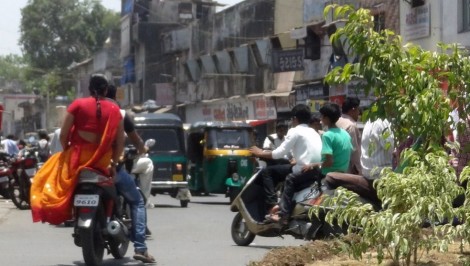
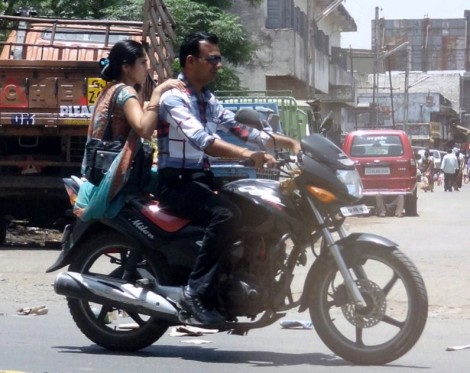
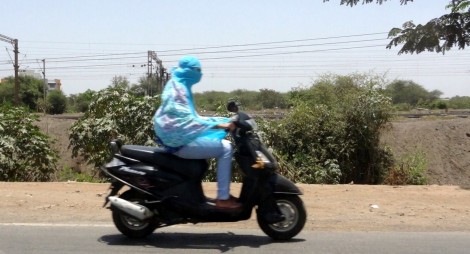

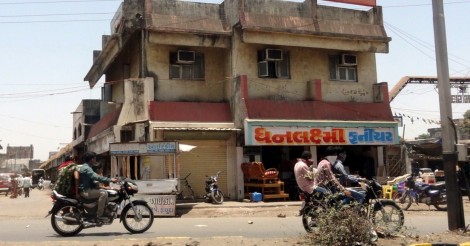
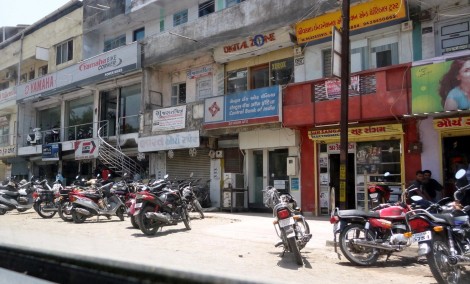
INDIA SIDE OF THE ARABIAN SEA
India borders on Pakistan which used to be a part of India. And across the Arabian Sea lies Iraq and Iran. I stood on the beach of the Arabian Sea and considered how close I was to these countries. All around me were India’s citizens not concerned in the least as to what countries surrounded them.
The Sea, and the beach, are milk chocolate colored. We had come to visit the sea and a couple of temples. We stayed at a guest house at the temple by the Sea. Lovely place. We drove to the second temple near another section of the beach. Both were very different and honoring different gods or people. In the second temple people came in bearing flowers they laid at the base of a pedestal with a marble cow.

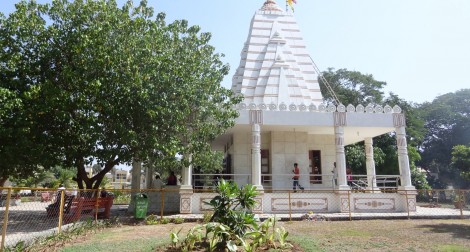
Religion appears to be an important part of everyday life here. There are many more religious holidays than we celebrate. But since many people here work 6 or 7 days a week it seems a great way to have some time off.
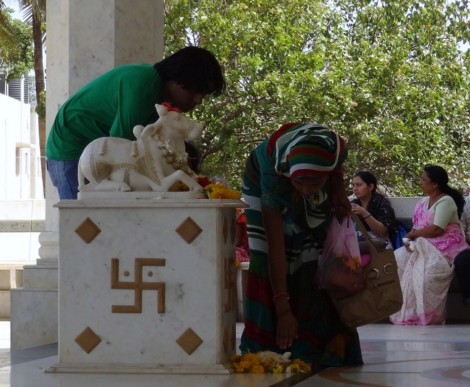
People touched the cow various places and then touched places on their face and chest. They would then touch the floor of the temple before they went in. A “monk” blessed them as they went out with a few very small pieces of coconut.
The base of the cow had an ancient Hindi Sanscrit symbol. Apparently the swastika design has been around much longer than the German use of it.
At the entrance to the beach was a fruit market with vendors selling all sorts of fruits – some I did not recognize.
Coconut water is a popular drink here. They simply hack off the top of the coconut with a machete and hand it to you with a straw.
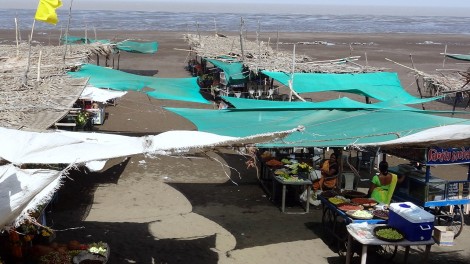
Note that there are no bathing suits on the beach. Even children swam in their clothes.
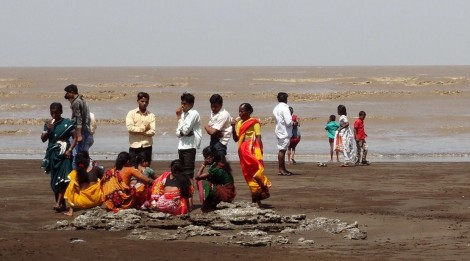
TRAVELING IN INDIA
Traveling is a real adventure in this part of India. It is common for cars here to zoom in and out of traffic amidst much horn blowing. Horn blowing is even encouraged as most trucks have “BLOW HORN PLEASE” painted on the back, maybe because they have less visibility and maneuverability. I am almost used to the constant zooming in and out of lanes by the driver. I am still not comfortable with the tailgating or the practice of passing as soon as the other car just begins to move over, leaving barely enough width for our car to go through.
I never realized that waiting to pass until the other car was actually OUT of my lane must be just an American thing! Lanes, too, seem to be optional here. Even as to which side of the road to use. On three occasions in our 4 hours on the divided expressway all of a sudden there was a string of trucks facing us in “our” lane on our side. We moved over. Disconcerting! I asked the driver about this. His response, “Is India; no rules.” Actually not a true statement but certainly some rules are more frequently ignored.
We shared the expressway with many types of vehicles, including people pushing carts, walking and bicycles. People and animals also crossed the expressway. We had to stop once for the cows.
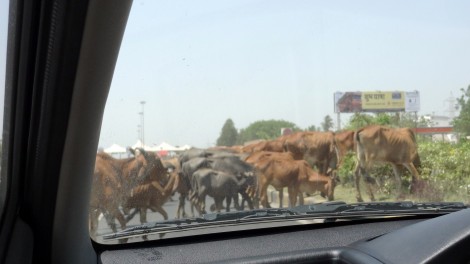
Buses are also popular but have never seen one as packed as the popular little yellow and green cars. There are bright yellow school buses for taking children to some schools. I say some as there weren’t school buses for the village schools we visited.
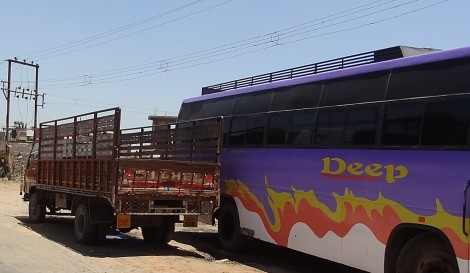
There are many types of vehicles here. Here’s another picture of a very stuffed little car.
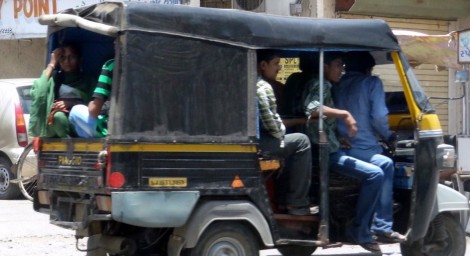
There are all sorts of trucks. But I’ve yet to see a pickup truck that are so popular in the US.
No Chevy Silverado anywhere. There are very small trucks and there are huge trucks.
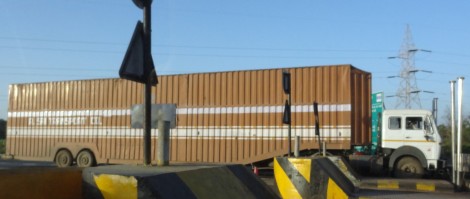
Many farm type trucks with open beds and wooden slat sides. They carry loads at least twice as tall as anything you see in the states. Note the huge load of bags on the truck as compared to the small truck right behind it.
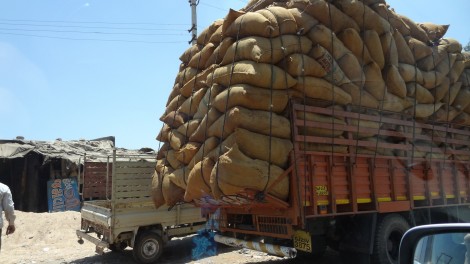
India is the home of the world’s cheapest car, a TATA. There are also many TATA trucks on the road.
Most trucks are very colorful with designs on the front and sides. It’s actually a bit unusual to see one simply white.

Then there are the unique vehicles like the three wheel modified scooter turned into a truck.

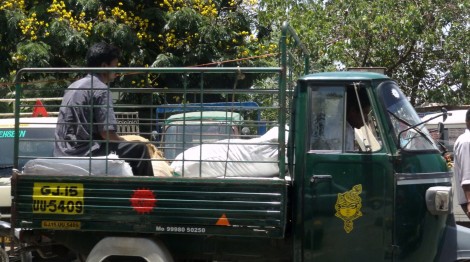
And, I am sure you are dying to know what I was riding in – a Toyota. And the color? White like most of the cars here.
Another popular color is light grey. There is an occasional red car and a rare baby blue – but that’s it.
TRIBES AND HANDICRAFTS IN INDIA
We visited several tribes with various types of handicrafts. We watched copper bells being made and a sample of the work of painting with a stick using boiled caster oil. In one of the tribes the men were known for their delightful Lacquer work on a variety of household objects. The women and young girls made jewelry and small cloth dolls and animals. They laid their work out for us. The children were with the adults and helping to show the merchandise. This child was particularly beautiful and my all time favorite people picture I made during the trip.
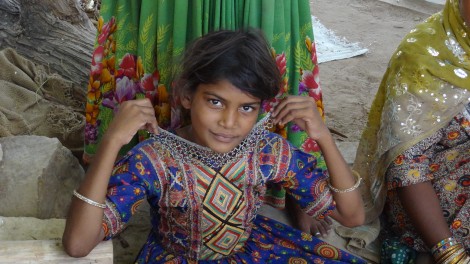
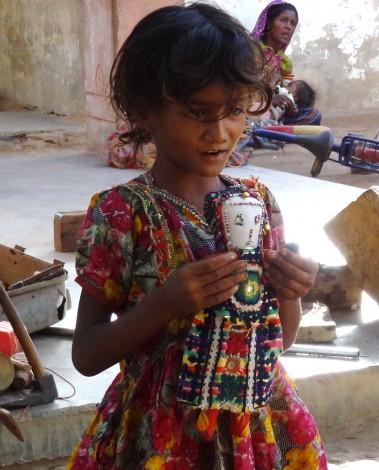
The men did excellent lacquer work on a variety of wooden objects. This man worked on a hand (with a little help from his feet) lathe.

His father, the older man, had passed this craft down to his son.

These gracious people lived outside of the “handicraft” village. They were not allowed to live with the other artists as they were descendants of the group of people known as the “untouchables.”
This prejudice, while still alive and well, is significantly decreasing across India today.
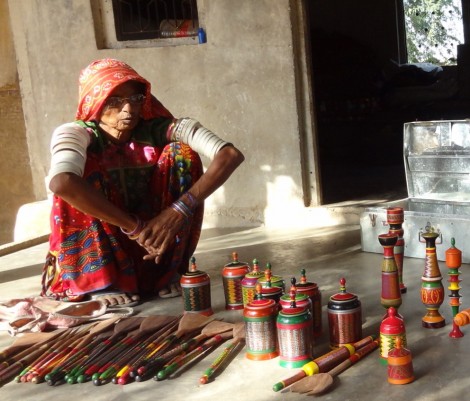
What is with the human race that we seem to pick another group to feel superior to? It will be a real sign of civilization and maturity when we can see people as just people.
TRASH COLLECTION IN INDIA
Trash is most everywhere. There are houses and businesses that are raked clean much of the time by servants but for the most part trash and garbage is just tossed out. There are no small trash bins or cans on the streets. “Please Don’t Litter” signs are non existent. There are dumpster type containers on wheels in my niece’s neighborhood but in the several weeks I’ve been here it hasn’t been emptied. And, it hasn’t really needed to be. Seems few put their trash in the container. And, when they do, someone tends to go through it without putting it back in the dumpster.
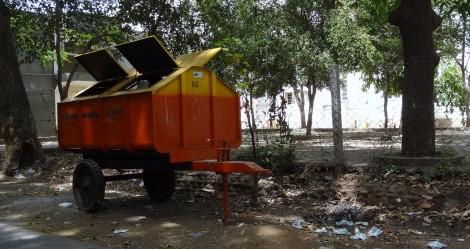
Surprisingly though, there is very little smell anywhere. Between the cows and the dogs and the monkeys any food stuffs are quickly disposed of.
The dogs run free and pretty much all look alike: light brown, thin, about 20 inches tall. Dogs do not seem to be pets here and while I’ve seen the occasional black dog, I’ve only seen one different breed as a pet. Not seen many cats either.
It is not clear who owns the cows that wander the streets. Many families do keep a cow for the milk and anyone fortunate enough to have a cow sells the extra milk to neighbors or the Amul Coop for small milk producers – there are 3 million of these small milk producers who “own” Amul. They do drink a lot of buttermilk, said to be “the best” buttermilk anywhere. My niece agrees. It is common to order buttermilk with your meal. After all, it helps soothe the palate after the hot spicy food. But, I am a no-milk-of-any-kind gal so the quality of the buttermilk is lost on me.
There is a big recycle program, but the poor are actually the best recyclers. Someone quickly collects the cardboard. Containers are reused or recycled in some way. There is less packaging than in the US. The little shops carry goods that are most often packed in heavy plastic pouches rather than boxes. Much of the paper is burned in fires for cooking and heating water. Most of the remaining trash is small pieces of paper and all kinds of plastic: bags, bottles, other items.
The few store keepers who do sweep trash away from the front of their store, and residents whose servants sweep in front of their house, most frequently sweep it to the street or to the next property.
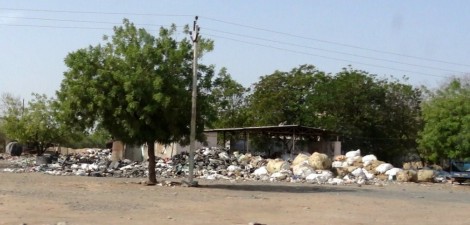
I’ve never seen anyone actually pick it up and put it in the dumpster. But surely at some point that does happen as garbage does seem to be collected and placed in large white bags. At some point these bags are gathered and transported by truck to a disposal place.

CAMELS IN INDIA
Camels are a frequent site in Gujarat. A camel was towing the wagon carrying this gypsy family from one place to another.

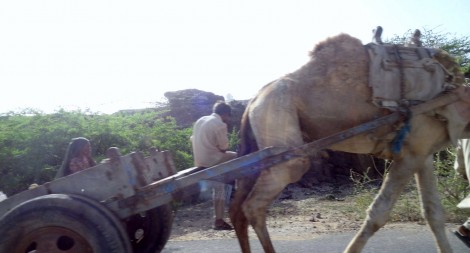
On our trip to Kutch we visited the salt flats and literally miles from nowhere was a camel kneeling in the salt. Its owner was sleeping under the cart waiting for a customer to come for a ride on the salt flats. We decided to do some walking ourselves and passed the opportunity to ride a flat cart behind a camel in the salt.
By far the most entertaining use of a camel was on the beach. Camels were “dressed up” and took unsuspecting tourists out for a lark (i.e. us) on a very bumpy uncomfortable ride around the beach. Cost: 40 rupees, or about 75 cents for both Dee and I. Our guide took a video of the event which Dee, my niece, edited and put on Facebook.
Here’s a picture of other tourists riding the camel.

 Our guide wrote Ann in Gugarati. Looks like squiggles to me. But the children here learn our alphabet and Gujarati and a couple of other languages as well. My hat’s off to them! an American kindergartner only has to learn to recognize 4 different symbols for each letter: the capital A, small round a, this ‘a’ that is used in print and a cursive a. It really is a wonder that we learn to read at all.
Our guide wrote Ann in Gugarati. Looks like squiggles to me. But the children here learn our alphabet and Gujarati and a couple of other languages as well. My hat’s off to them! an American kindergartner only has to learn to recognize 4 different symbols for each letter: the capital A, small round a, this ‘a’ that is used in print and a cursive a. It really is a wonder that we learn to read at all.
MAKING MASALA IN INDIA
There are lots of restaurants in Anand. We had lunch at Sahyog. We chose the “fixed lunch” which means their special for the day. I don’t know what it was but it was very tasty and some of the best Roti I’ve had here.
Roti is a flat bread made from wheat flour, a small amount of oil, salt and water. This thick mixture is then kneaded for a couple of minutes, rolled into balls, and rolled out very flat. It is then basically tasted in a pan with no oil. When it is cooked you slide it off the pan directly onto an open fire. It puffs up like a balloon then goes flat as soon as removed from the flame. I’ve watched the process on a gas stove and an open fire several times and it still fascinates me. I was thrilled to catch this picture at just the right moment.
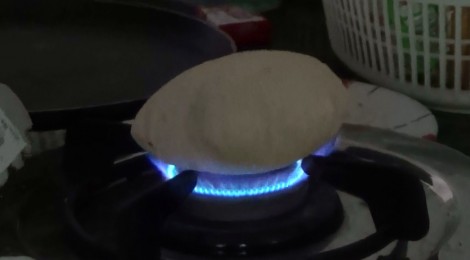
In the US the servings are ridiculously large, so much so that I never can eat it all. The servings here are much more reasonable. Sometimes, though, at first it may not seem that it would be enough but I eat my fill and still leave some on my plate.
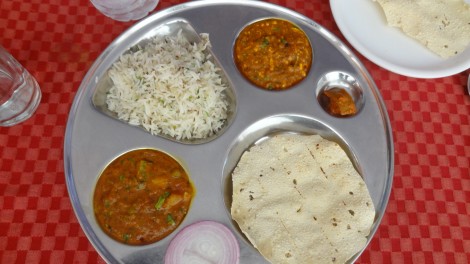
On our way home from lunch we saw a group of women in sarees sitting on a large cement porch pounding 12 inch rounded sticks into gallon cans. Curious, we paused to watch and were invited into the compound.
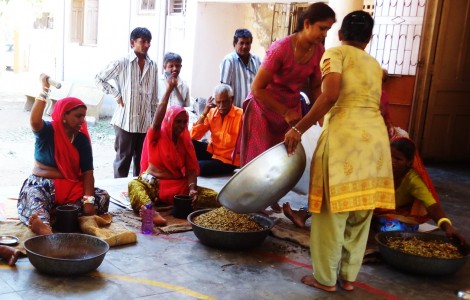
The woman who appeared in charge spoke some English and explained that this was some sort of community program or co-op that had local women working to produce Masala, a mixture of spices that is commonly used. They pounded the raw spices in the cans into powder. After dumping the powder into another bowl their cans were loaded up again with a mixture of spices. The powder was then sifted for any remaining bits, packaged in small plastic bags and sold. The money goes back to the women to buy what they need.
CLOTHES SHOPPING IN INDIA
My niece lives in a suburb of Anand, a city of over 300,000 people, in an area called Vallabh Vidhyanagar which I have given up trying to pronounce. Vallabh Vidhyanagar is basically a university town, a residential area containing lots of houses, dormitories and college buildings of various types. There are some small shops here and lots of street carts selling mostly fruit and vegetables and prepared food and tea.
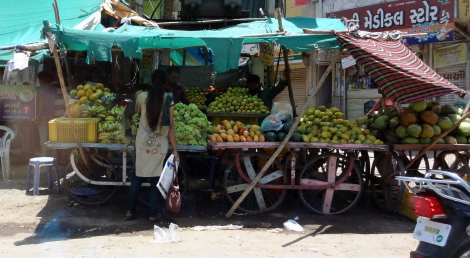
For serious shopping you go into Anand to either the larger specialty or department type stores or to the bazaar.
The shopping area is too far to walk so we hired a car, which is sort of like calling a taxi, and went to the bazaar, which is sort of like going to the covered mall – sorta. Much of it is rows of shops lining narrow alleys with canvas shades. Lots of shops selling a variety of necessary, and unnecessary, goods. The variety of colors and types of goods and how packed the shops were combined with the colorful clothes worn by the shoppers was a bit overwhelming to see. It is a lot to take in.
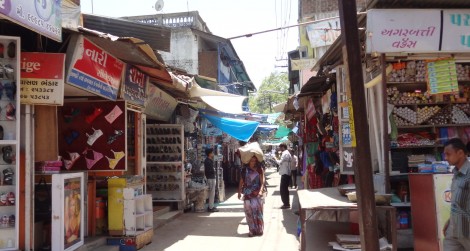
There is no air conditioning in any of the narrow stalls which bring to mind single car garages with pull down doors. In the USA often there is a problem finding someone to help you – not here. I never saw less than 3 people in each of the small shops ready to help. Goods line the wall floor to ceiling so they bring you whatever you are interested in.
I was shopping for the long tunic, a type of loose blouse. This blouse and baggie pants is probably the most common outfit worn by women here. It is very comfortable in the way pajamas are comfy. Loose and baggy is good in this heat. Since this is a college town a lot of the younger people dress more in the “western” style, as they do in the large cities but it is not as popular as you’d think. Jeans after all are hotter than light weight cotton loose pants or the long full loose skirt of the sarees. To make the 3 piece outfit, loose pants, tunic and dupatta, or scarf, you purchase a set of 3 material pieces , one for each piece of the outfit. This material is all selected to coordinate.
Note how colorful all the materials are. The women in India dress in very colorful ways.
I’m told that it is important to dress colorfully so that the gods will notice and protect you.
Yellow and red that decorate the cars also have a religious significance.
There is little mix and match of various different colors, it all fits together.
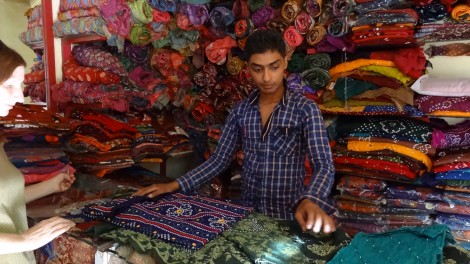
There is ready made clothing here, but much of the time the outfits are sewn by seamstresses. Sizes are different too. In the states I am a medium; here I am considered extra large – a blow to my ego let me tell you. But, ego or not, here I am in my comfy clothes.
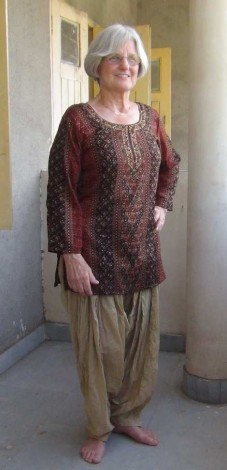
Many of the women wear a sari or saree all the time. Generally about 4 to 9 yards of material wrapped around yourself in particular ways depending on where you are from. Or, where you belong. People identify themselves as, “I belong to (city or area name). Clothes often do tell a lot about the person wearing them. The type of materials, the colors used, the designs and styles of embroidery and trim all identify you. Your clothes tell a story of where you are from, what caste (unfortunately that’s still an issue here), how old, and marital status.
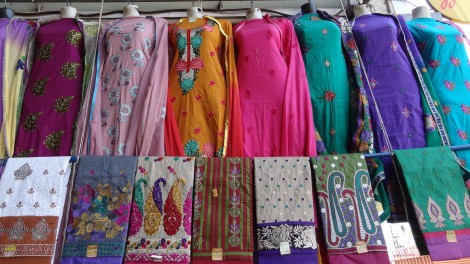
ELECTRICITY IN INDIA
Keep in mind dear reader that India is a large country with 28 states. India is about 1/3 the size of the USA but with about 4 times as many people. I am visiting one state: Gujarat – and only part of it. I am very aware that I cannot extrapolate everything in this area to all of India, or all of Gujarat.
To say I have seen India because I’ve seen part of Gujarat is like saying I’ve seen, and therefor understand, the entire United States having only been to South Georgia when the corn is ripe, and visited the Okefenokee Swamp and Albany.
Which, by the way, since I’m from Georgia I have. OK, I’m aware that most of you have no clue what or where the Okefenokee Swamp and Albany are. Isn’t Google an awesome resource for finding out such things?
I spend part of my winters in a rather primitive part of Texas – Terlingua – where many of my neighbors are “off the grid” using solar, wind power or generators, have water catchment systems and live on dirt roads. So, I am fascinated with the infrastructure in India particularly the electrical system.
Power is generally reliable but certainly not consistent. It is common in the Anand area for the power to go out occasionally – and always so far on Sundays from about 9am to 3 or 4 pm. I’ve not been given a decent explanation. My niece tells me this has happened for the 18 months she’s been here. No power, of course, means no air conditioning; May is the hottest month of the year and can get up well over 100F. And there are no air conditioned malls to escape to, and even if there were such a shopping mall here their power would be off too. The worst part is a couple of hours after the power goes off generally so does the water which is pumped to the roof then dispensed by gravity. Once the tank for the building gets low – no water.
The power system in Gujarat is a mixture of modern and antiquated. Like Europe they have 220 instead of our 110 volt. Their plugs are different as well. The outlets in the house are located 3 to 4 feet from the floor; a much more practical location than next to the floor.

The electrical boxes on the street are accessible. The US is very risk adverse as a nation. Not so much here. For instance, I’ve not seen anyone wearing seat belts and of the literally thousands of scooters and motor cycles only 2 were wearing helmets. People walk on the side of the expressways and cows and other animals are frequently driven across even the busiest expressways – you just wait on them. After all, cows are sacred; you just don’t hit a cow. There are also no heavy locks or gates around electrical equipment. No protection from someone deciding to stick their hand in an electrical box on the street just to see what would happen. Don’t think OSHA standards are standard here.
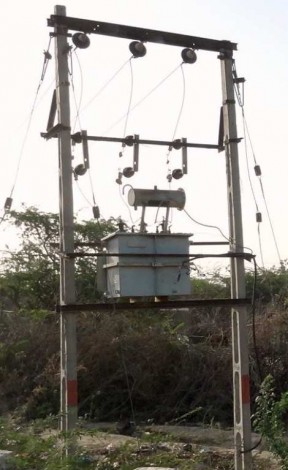
India has other sources of power, too. We saw “wind farms” in Northern Gujarat – a much windier place.
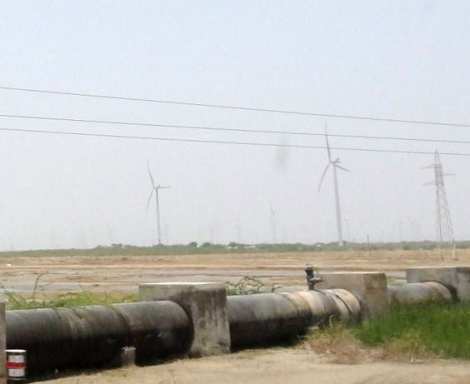
And, yes, they have solar power here but the only place I saw it was for an ATM near the tribal areas in North Gujarat. Smart. Makes it handy for tourists wanting to buy handicrafts as these folks certainly did not take American Express. In fact, the only place I’ve been able to use my VISA card – they prefer debit – was at the hotels and a large department type store – and then, of course, only when the power was on! Fortunately, they do have ATMs in most towns.
USING YOUR HEAD IN INDIA
Women seen carrying large loads on their heads and often for several miles. I was fascinated by these women.
But, surely, that can’t be good for their necks or spines over time can it?
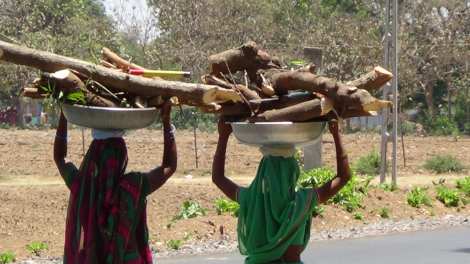
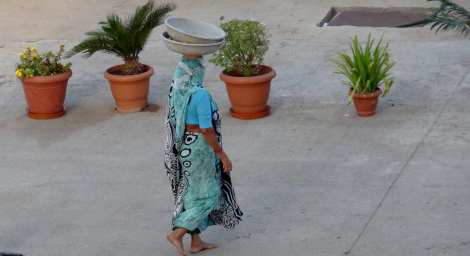

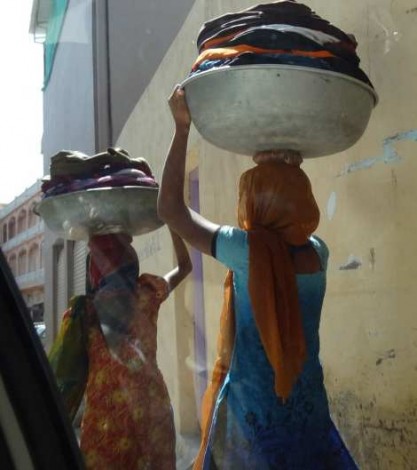
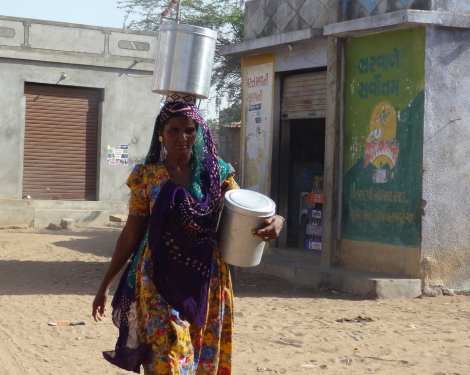
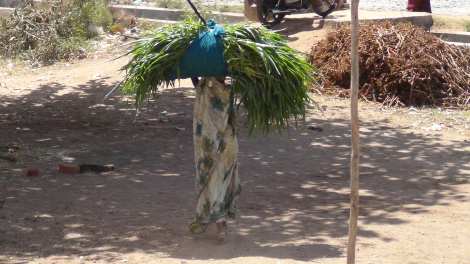

WEDDINGS IN INDIA
When we were at the village school in Tranol a wedding party paraded by the back walled area of the school overlooking a dirt road coming into town. I was able to film the wedding procession as it proceeded down the road. Everyone was dressed in colorful clothes and the men were made even more colorful because they threw “colors” on each other. Colors are sort of like throwing various colors of dry tempra powder at someone. All of the wedding party were in their best, and very colorful, sarees. Some rode in a truck that looked like a large farm truck designed to carry wheat bales. Most just walked behind the musicians. I’m told there is a religious symbolism in the bowls of green grass the men are carrying on their heads.
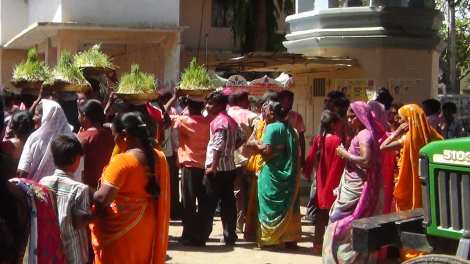
Weddings are often a weekend long affair with a party at the bride’s house and a party at the groom’s house. The guests are fed and bedded for the weekend, at times resulting on wall to wall pallets on the floor for sleeping and sitting.
We saw another wedding as we were driving to dinner one night. It was a colorful event. As they danced and partied the wedding blocked about 300 feet of one lane of the divided highway leading out of town. The traffic had to drive on the wrong side of the road for a few hundred feet to get around them. I’m told that weddings blocking roads and traffic is not uncommon – for that matter driving on the wrong side of the road happens a lot as well.
White horses and fancy carriages are often used in a wedding. This pair of horses were headed back to the stable after a wedding. I didn’t see other horses in the area. I’m sure there is a story there but didn’t find out why there were no horses around except the white wedding ones.
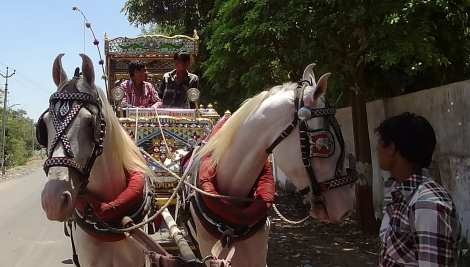
For the most part, weddings are still arranged in India. Generally, but not always, the woman meets the prospective groom prior to the marriage arrangement. Generally, but not always, the woman can refuse to marry a prospect. One of the reasons women go on to higher education is to be able to attract a “better” husband as each prospective bride and groom have a type of “resume” so that a matchmaker can approach various prospects for compatibility of family background, economic position, general character, family reputation, the value of the dowry, the effect of alliance on property, and other issues of importance to the family. Their horoscopes are also thoroughly reviewed for compatibility as well. The matchmaker is used as an intermediary so you do not have to directly deal with any hurt feelings if things don’t work out.
Demanding a dowry has been illegal since 1961 but is often ignored or families use the loop hole of calling it “wedding gifts.” The legal age for marriage is 18 but that is often over looked as well, particularly in the smaller more rural villages.
A very young girl can be married and live in her husband’s home being trained by the mother-in-law for 3 to 6 years before the marriage is actually consummated. Some of the logic used to justify early marriages is: assure her virginity, protect her from rape, keep her from running off to marry someone not approved of, provide an alliance beneficial to each of the two families (whether it is of benefit to the couple is not an issue), maintains parental control Young people are not encouraged to be independent or to live on their own, married or not.
Ekta, the teacher in training you met earlier, has an older brother. He married just a few months before I arrived. He and his bride moved into the family home where his wife is being taught by his mother how to best take care of her son. The parents in this case gave up their private sleeping quarters to the newly weds.
With responsible, mature, benevolent parents with the true interests of their children at heart this arrangement generally works out just fine, but horror stories also are common.
BHUJ, INDIA
The salt flats in Kutch are close to the Pakistan Border – so close that we had to have a government permit to enter. This process took over 45 minutes. Good thing there weren’t many tourists in the area – there would have been a very long line and wait if there had. Because we don’t speak the language, drive on the “wrong” side of the road or know where we were going we hired a guide along with a driver and set out. We wanted to visit and see several native tribes with superb handicrafts in this area. We passed the Tropic of Cancer and, even with the wind blowing we took the obligatory picture at the sign by the side of the road. Wonder how many wind blown tourists have had their picture taken here!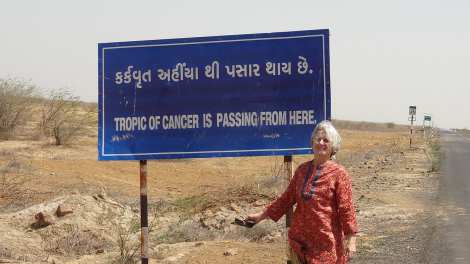
The salt flats in India are protected lands, like our national parks. And, like our national parks are a popular Indian vacation spot. Literally thousands come on certain holiday times and camp close by. The salt water is just below the surface as shown by our guide poking a hole in the salt with water quickly accumulating the indentation.
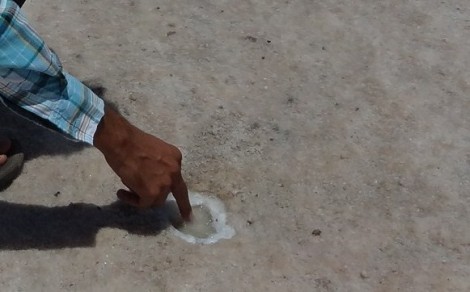
Camel resting in the salt flats waiting for a customer.
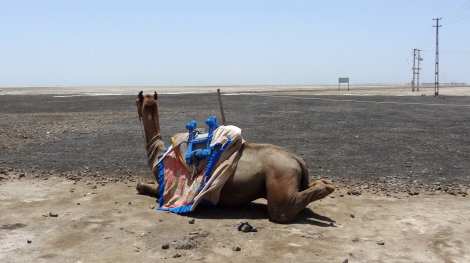
We stopped for lunch at a place that created plaster walls with small mirrors embedded.
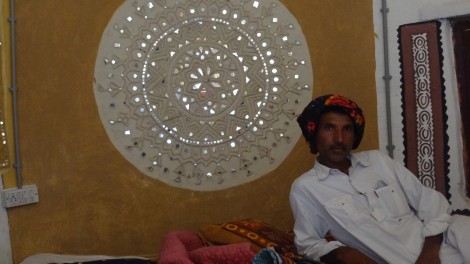
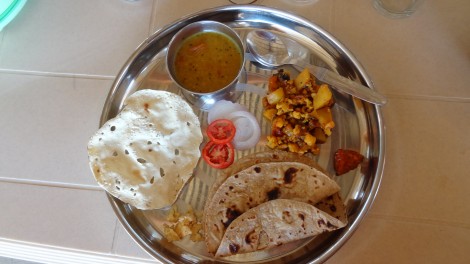
Some of the women there wore very large nose rings. This is not a good picture but the ring you see is the ring they wear in their nose; it’s about 3 inches long. They have a decorative ribbon from their headdress to help hold up the weight. I simply cannot image wearing such a thing daily.
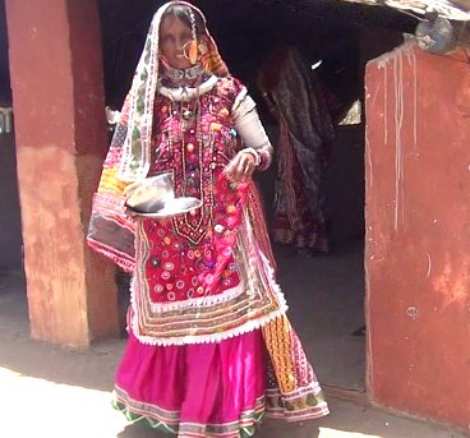
And, maybe they don’t. After lunch the women laid out many of their handcrafts for us to see – and hopefully buy. This woman, with a smaller nose ring, was feeding her baby.

STEPWELLS IN INDIA
On our way home from the Kutch area we stopped at 3 stepwells. Before India I had no idea what a stepwell was, not sure I’d even heard the word. Stepwells are all over Gujarat – each stepwell creates a small lake with various designs of steps around it. They were built as places of rest and relaxation for travelers in this desert region but I bet the locals used them a lot as well.
The name, stepwell, is very descriptive. It is a well deep in the ground with steps built in the walls to be able to go and sit by the water regardless of the depth.
This Ramakund Stepwell, in the middle of a town, is treated like a park with a fence around it. It is the smallest of the three we saw.
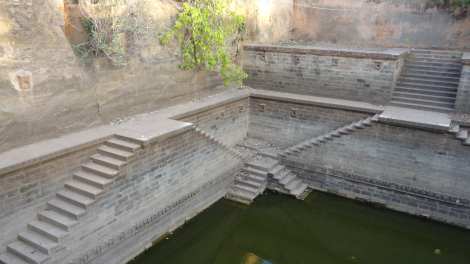
The Patan Stepwell is one of the most famous and largest and is part of a very large park surrounding it. It is in the middle of acres of a grassy area park. People were sitting or picnicking on the lawn. This deeper section, just below, was closed off to everyone. Apparently, it hasn’t held water in a long time. Since this was a tourist attraction we paid to get in and paid extra to take pictures. There was a scale of payments with it being very cheap to come in if you were a resident of India, a bit more if you were a non resident Indian, a fair amount more – but still cheap by our standards – if you were a foreigner.
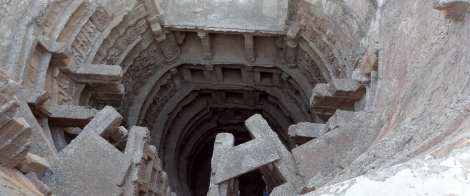
We walked down, down, into the main section.
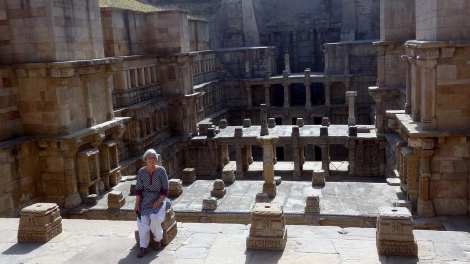
The below Stepwell was a part of the Sun Temple at Modhera, one of the very oldest temples in India built in 1026. There are 7 sun temples in India designed so that the rays of the Sun would fall on the image of Surya at the time of the equinoxes. The Hindu religion refers to the sun as the store house of inexhaustible power and radiance. The sun god is referred to as Surya or Aditya. You can get some idea of how big this was by noting the tiny people standing in the corner.
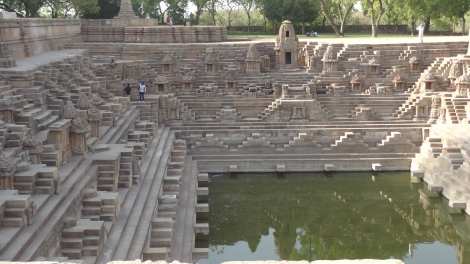
INTERESTING INDIA
My visit to my niece and India is winding down. While writing about the experience in India could easily take up a whole book (and lots have by others) this will be the penultimate post about India. It’s been an incredible adventure. A month is a long time to be away from home but only a brief time to see and get to know any new place. I’ve only “scratched the surface.” I wanted to show you more even more pictures of this fascinating area and its people – especially its people.
The Fruit Stand

A huge Banyon Tree
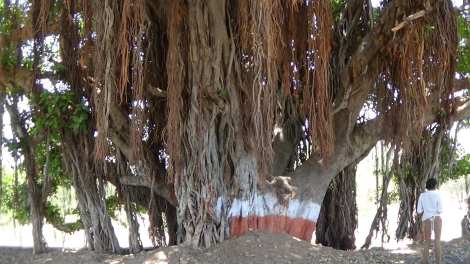
Child care is predominantly done by women but it was not unusual to see an involved father.
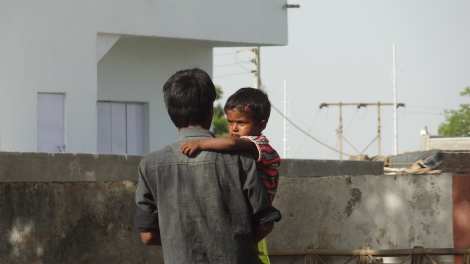
Gypsy Man
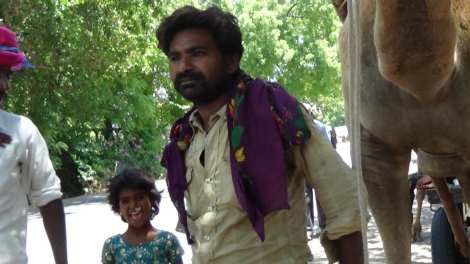
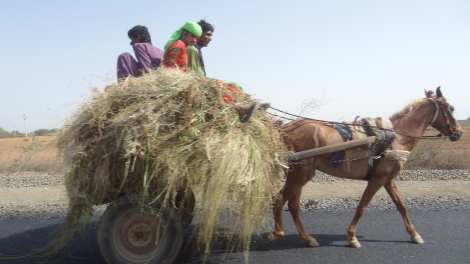
School girls of Travol

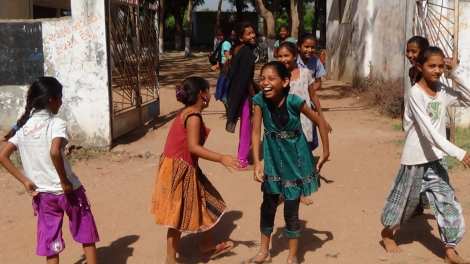
Street Children – you could identify them by the sun bleached hair and their dirty clothes.
These children probably did not go to school.
School attendance is so bad in the general population that governments often pay the parents to send their children to school.
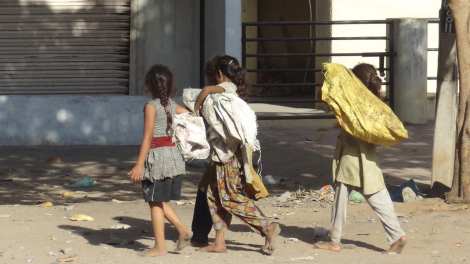
Sun Temple carvings from the 4th century.
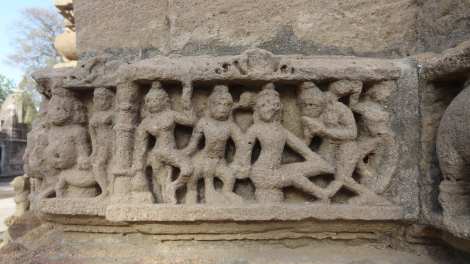
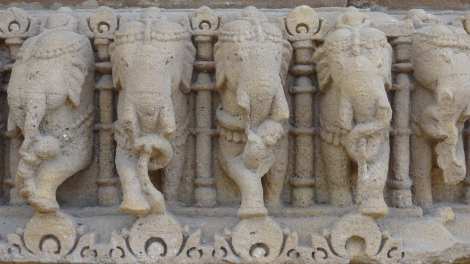
Gypsy Baby – my niece in the background taking more pictures. We took LOTS of pictures.
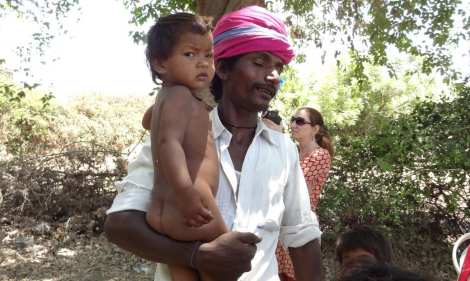
The king’s graveyard from the 4th century
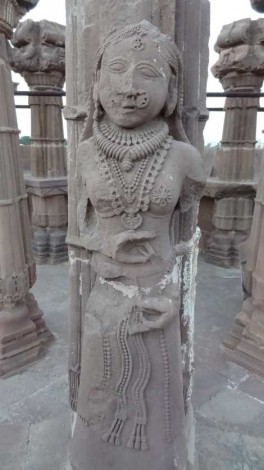
What a buffet looks like in India – it was really really good. I enjoyed the food.
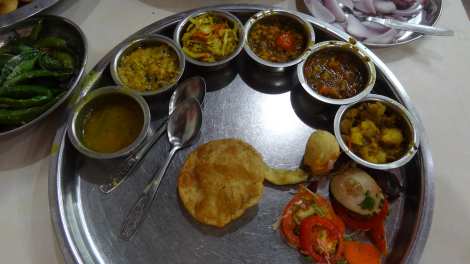
Some temples are the color of sand castles, others white but some are painted all sorts of bright colors.
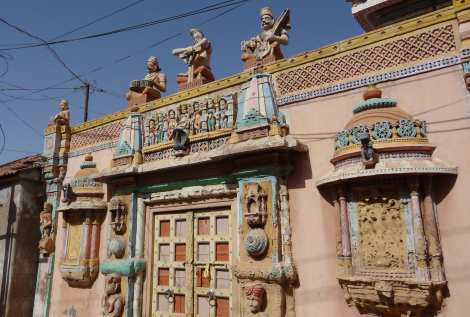
At lunch another picture of the woman with the baby.
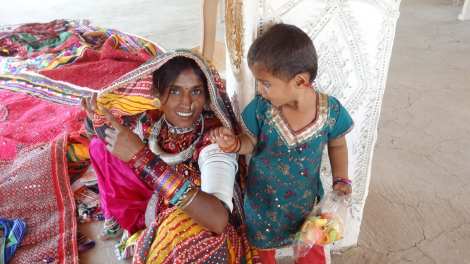
Kids finishing lunch. Note the line of girls and line of boys.
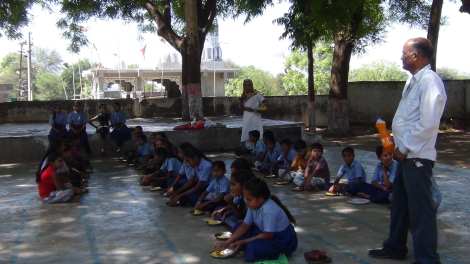
The untouchable women selling their lacquered wares.
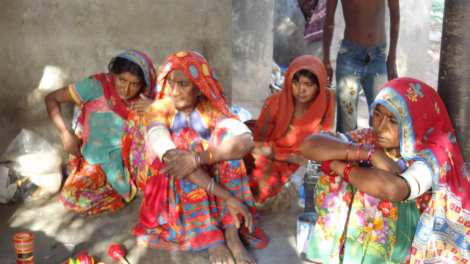
A 4 X 4 kitchen
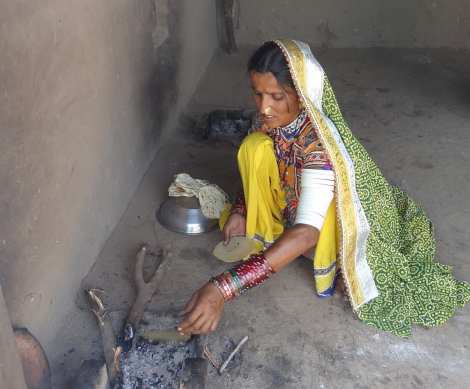
Cows cooling off in the mud
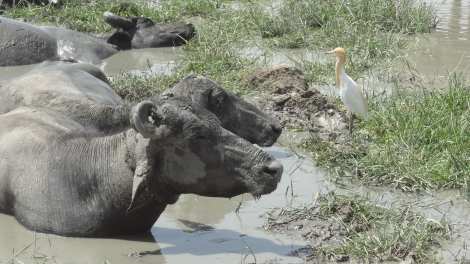
Ekta with her hair down
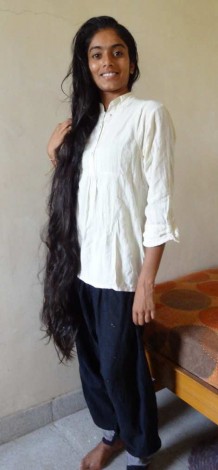
Typical Gujarat classroom
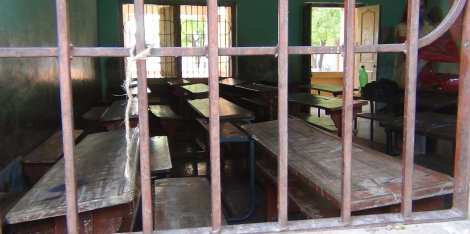
Note all the hand embroidery

Sunset at the kings graveyard – this is one of my favorite pictures
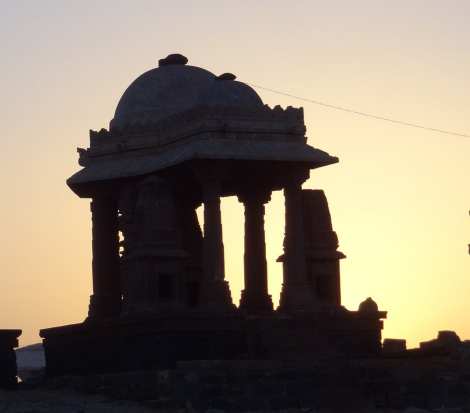
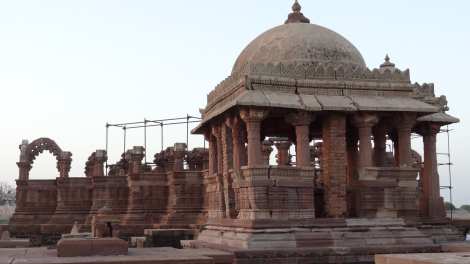
At the Market
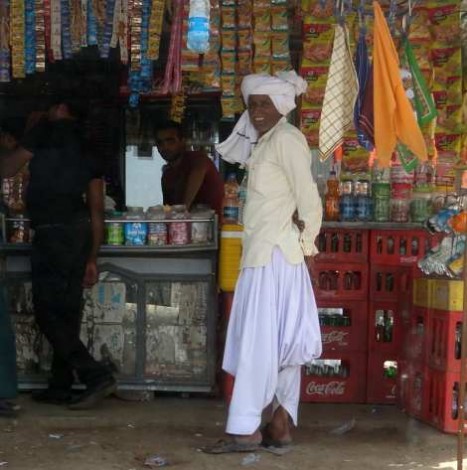
Common shrubs and bushes along the side of the street.
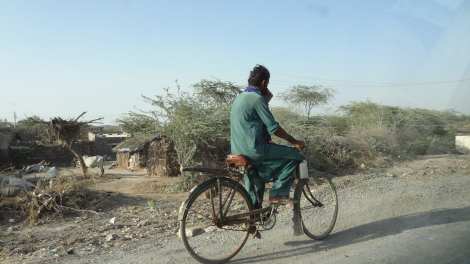
A school teacher giving a couple of kids a ride home.
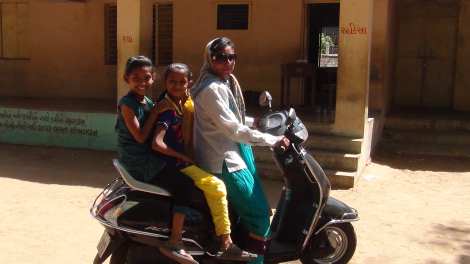
The new temple to replace the one destroyed by the earthquake. There was criticism that the money was spent on a temple.
Particularly the foreign visitors felt it should have been spent on the people.
Actually it was spent on the people. Religion and their temples are very important to them.
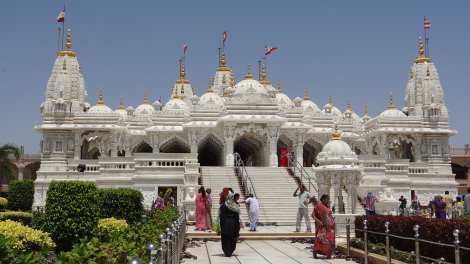
A Statue of a god outside the temple
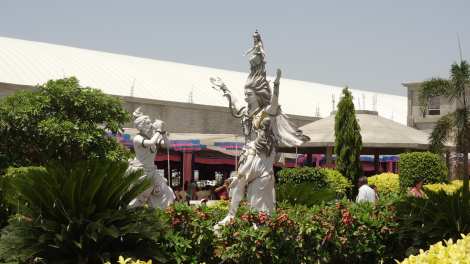
Beds like this one are frequently found outside even at restaurants for people to take a rest. We often saw people on them.
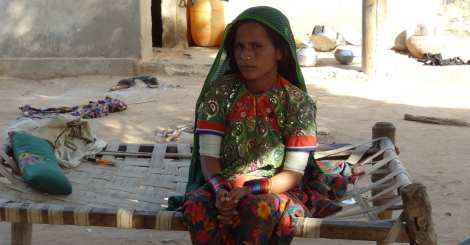
The untouchable children showing off their dolls. Getting a bit bored with sales!
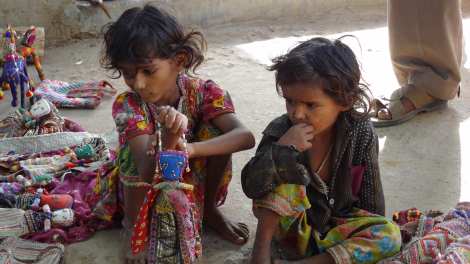
It appeared that all the women came out to show their wares. We were there “off season.”
They were particularly glad to see us.
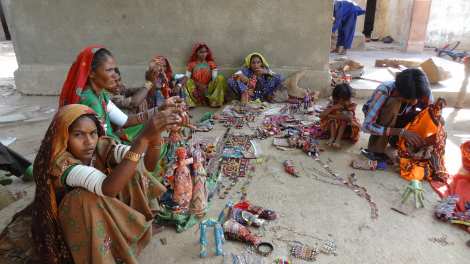
A vegetable cart on the street.

Monkey’s on the fence and in the trees seen from Dee’s apartment windows.
A key reason for the bars on the windows on the second floor.
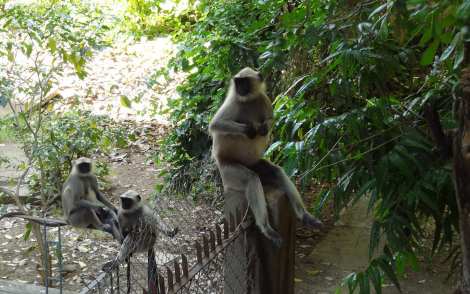
Walking to the church
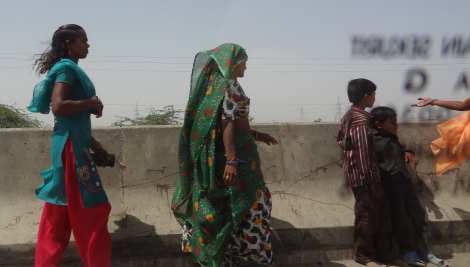
Headed home from town
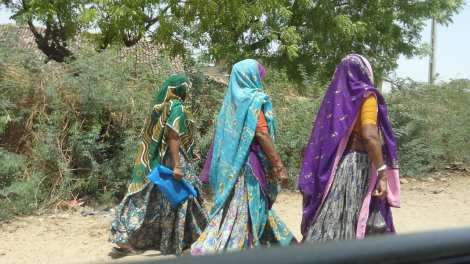
LEAVING INDIA
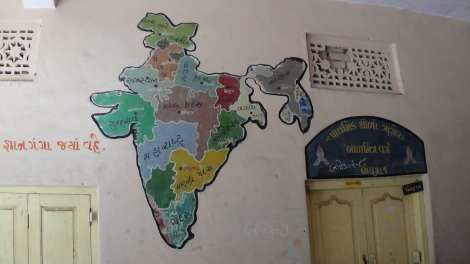
In case you’ve been wondering where Gujarat is above is a map of India painted on the outside wall of one of the village schools.
Gujarat is the green alligator head on the left.
All good things must come to an end – this is my last blog about my trip to India. I took a taxi for the trip to Vadadora airport for the last flight at night to Mumbia where I then boarded a packed bus for the ride to the international airport.
For the first time in a month, on that packed bus, I was not the only other non Indian. My niece is the only US citizen, indeed, only non Indian in her area that I saw. I visited India “off season” because of the heat but apparently Anand is not a big tourist area any time. There were 7 of us on that bus to the airplane: a German auditor, a couple of college students from Switzerland and a family of three from Detroit with their 7 year old daughter. The child was blond and her mother told me everywhere they went people wanted to take a picture with her. These were the first Americans I had seen the month I spent in rural Gujarat.
Security was about like it is anywhere in an airport and, since my flight wasn’t for 5 hours, I went shopping in the airport mall. Mumbia is a large city with a very large airport contaning many modern shops and restaurants. I bought 2 elephants and I spent my remaining 220 rupies on a blank notebook made from elephant dung. Yes, you read right – dung. Why? I have a 10 year old neighbor interested in such things.
It was 44C (111F) when I left Anand; it was 11C (52F) when I arrived in London – what a difference a few miles make – well a lot of miles. I hung out in a London airport restaurant reading a book and drinking tea. Black tea – with a smile on my face – I prefer tea that way.
In Gujarat, tea is actually brewed in milk with sugar and spices added and given to you in a plastic cup. Tea carts by the road or places of business were common. Gather a propane tank of gas, gas stove top, big pot, cabinet for tea supplies, cart to carry it on and you are in business. The tea is really good but more like hot chocolate to me than tea. It is sort of the social thing to do, like inviting someone to go have a cup of coffee, or meeting someone at Starbucks.
I decided to wear my Indian clothes home, they are very comfortable. What people choose to wear on airplanes is always interesting. I looked around the London airport – another 5 hour wait. Now only a few sarees and the more casual Indian clothes like I had on, even less Indian dress on the flight to Dallas, Texas where each Indian there caught my eye and smiled. Some outfits were comfortable and tasteful; others not so much. A lacy pink dress with pink tights; shorts and tank top; an outfit of primary colors like in a box of 8 crayons: blue pants, yellow shoes, green jacket, red purse, black bag, white scarf; lots of jeans and knit shirts; a few business suits for men and women; khaki pants and button downs; sweat suits; long skirts, short dresses and in between; sandals, flip flops, tennis shoes, high top canvas shoes, UGGS, business shoes, flats, high heels and higher heels – how do women walk in those things?
I sat next to an Indian couple from Delhi. He was transferred to Dallas from Delhi by Samsung and had gone home to get married – an arranged marriage. They had not met before; she was scared. Made sense to me! She was maybe 20 or 21 and leaving absolutely everything she was familiar with to start a new intimate relationship, basically with a stranger. Wow! It is all a bit intimidating. My hat’s off to her and my empathy.
When I was in Turkey for 2 years I too left home, family, friends, normal activities and familiar environment, customs and culture for a country with different money and systems and language – with 2 babies in downtown Adana, Turkey. Even living off the base, however, there were lots of other folks from the USA. This young Indian bride had studied English but like most of the Indians I’d met she could read and understand much more than she could speak. All that would be a challenge on anyone. Fortunately, for her there is a large Indian population in Dallas.
One thing that Indians are indeed known for is community and helping each other. While they may be taught the English way of saying please and thank you for everything, they rarely use these terms in their own language. It is not that they are rude, far from it. It is that, as a part of the natural course of things, they will help and receive help as needed. It is a given.
My niece is in a place with no other US citizens around. She consults at probably the most prestigious English Second Language teacher training program in India. Her colleagues at the university do all speak English, with an Indian accent, and she has learned a good bit of Gujarati. But it has to be tough for absolutely everything to be different and no one else around to “get” the many nuances inherent in any culture.
I was impressed with how well she’s adapted. She respects and is well respected by those she works with. And, I too, would like to add my deepest respect and admiration for my niece, Dee Broughton, who is striving to make a difference by working with others there to increase the effectiveness of their English Second Language teachers in the schools.
While more people in the world are non English speakers than are native born English speakers, much of business around the world, and most professional journals, are in English. It is common place outside the US for children to grow up speaking three or more languages, frequently that includes English. As one Indian told me, “English is the future.”
India recognizes this and is working to increase English all over India. India, especially Gujarat which has the highest per capita income in the country, is striving to resolve their many issues of infrastructure, especially roads, power and clean water and to give everyone the opportunity for an education.
Go Gujarat. Go India. I leave with fond memories.
It was a full moon in Gujarat 3 days after I arrived and there will be a full moon here 3 days after I return. Here’s the full moon in India.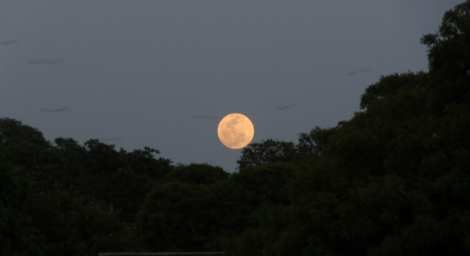

“Ann” as it is written in Gujarati. Thanks for making it this far!

